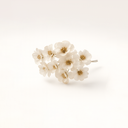How to Preserve Flowers?| Step 2 - Glycerin Rehydration

After low-temperature dehydration (similar to freeze-drying), fresh blooms retain their shape but become extremely dry and fragile. To prepare them for long-lasting beauty, the second step of the preserved flower process is glycerin rehydration—a controlled, plant-based method that restores softness and stability without returning the flower to a perishable state.
Why Rehydration Is Essential
Dehydrated petals and sepals have lost internal moisture and are prone to cracking or deformation. In this “capillary window,” floral tissues readily absorb a target liquid. By introducing a carefully formulated solution, we replace the lost sap with a stable, non-volatile moisturizer so the bloom regains flexibility and resilience.
What Is Plant-Based Glycerin?
Vegetable glycerin is a clear, colorless, nearly odorless humectant derived from plants. It binds water and slows evaporation, acting as a gentle, long-term softener for botanical tissues. Because of its safety profile, glycerin is widely used in food (texture/softness), cosmetics (skin hydration), and pharmaceutical formulations (solvent/vehicle).
Safety & Sustainability
- Non-toxic contact: food/skin-contact–grade usage demonstrates excellent safety when handled properly.
- Eco-conscious: plant origin, recyclable workflows, and closed-loop process design reduce waste.
- No perfumes or harsh solvents: the solution is designed to be neutral so the bloom’s natural texture is preserved.
Industrial vs. DIY: Why Control Matters
Home methods (simple soaking or spraying) lack precision. In contrast, ZESO uses industrial, closed-environment rehydration with tight control of temperature, humidity, solution concentration, and time. Freshly dried blooms are immersed and held for several days to achieve even uptake across petals, calyx, and stem interfaces. This yields batch-level consistency that DIY cannot match.
The Result: Structure, Texture, and Longevity
- Softness restored: petals become pliable and resilient instead of brittle.
- Shape preserved: the original form from the moment of harvest is maintained.
- Lasting stability: glycerin’s low volatility supports long-term suppleness without watering or sunlight.
About Color at This Stage
Rehydration is not a coloring step. Immediately after glycerin uptake, blooms typically appear white to pale (sometimes showing faint natural veining). This neutral “base state” is intentional—it prepares the flower for the next article’s topic: controlled color infusion.
See the Outcome
Explore ZESO’s preserved Focal Flowers—real blooms that have completed drying and glycerin rehydration, ready for long-lasting display and creative floral design.
Keywords: preserved flowers, glycerin rehydration, plant-based glycerin, flower preservation process, preserved roses, everlasting blooms, sustainable preserved flowers, industrial preservation.



